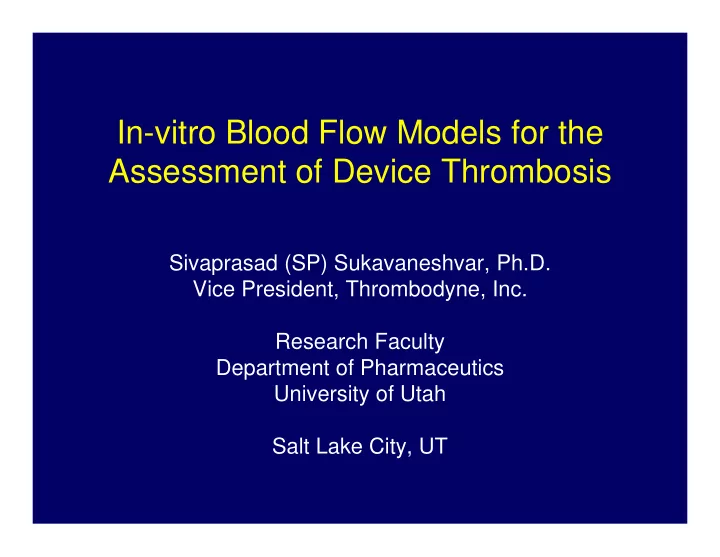

In-vitro Blood Flow Models for the Assessment of Device Thrombosis Sivaprasad (SP) Sukavaneshvar, Ph.D. Vice President, Thrombodyne, Inc. Research Faculty Department of Pharmaceutics University of Utah Salt Lake City, UT
Proteins Cells Blood Streamlined Virchow’s Device Triad Biomaterial Disturbed Flow Surface Slow/stagnant Vascular wall (Endothelium) Fast
Fluid Dynamics Shear Stress Platelet activation Normal velocity Platelet adhesion & aggregation Vorticity Platelet aggregation (fluid phase) Residence time Coagulation and consolidation
Surface Virchow’s Blood Triad Flow
Blood Flow Device In-vitro Blood flow surface Models
Assessment of Device Thrombosis Clinical studies In-vivo animal studies In-vitro flow model studies In-vitro static blood contact studies Surface characterization
In-vitro Blood Flow Model Configuration Blood 37˚C reservoir 37˚C Polymer Test Control/predicate Tubing Device Pump Variations: Branched flow, Single pass, Chandler loop, etc.
In-vitro Blood Flow Models: Key Features • Relative assessment of thrombosis and related processes • Fresh, anticoagulated whole blood – Heparin, citrate (recalcified), hirudin • Blood flow conditions approach clinical use – Flow rate and conduit size • Experiment time: ~hours
In-vitro Blood Flow Models: Key Features • Measured output – Macroscopic thrombus ( Weight, Visual analysis, Radiolabeling) – Microscopic components (SEM) – Fluid phase biomarkers – Thromboemboli – Device dysfunction caused by thrombus (occlusion) • Test conditions selected to focus on the device and minimize the impact of other model components – Surface/Volume ratio – Edge effects
MERITS OF IN-VITRO FLOW MODELS • Useful template for comparing device thrombosis under similar conditions • Some control over blood parameters • Control of other important parameters (e.g. flow)* • Quantification of thrombosis
LIMITATIONS OF IN-VITRO FLOW MODELS • Experiment duration • Absence of long-term effects – Blood vessel wall-device interactions – Comprehensive hemostatic pathways (e.g. lytic pathway) – Inflammatory and foreign body response • Need anticoagulation • Control of other parameters (e.g. flow)!
EXAMPLES
(flow disturbance) Device geometry Blood reactivity Device Thrombosis Surface modification Vascular response ?
Coronary Stents Model Configuration(s) Peristaltic pump Stent Initial flow rate: 75 ml/min Heparin: 1 U/ml Polymer Expt. Time: 60-90 min conduit Conduit: 3.2 mm ID 111-In labeled platelets Flow probe Blood Reservoir Conventional model Branched flow model
Uncoated (control) THROMBUS ON STENTS Coating A Coating B
Thrombotic Occlusion Coating B 75 Coating A Flowrate 50 ml/min Control 25 0 15 30 45 60 75 Time (min)
Coating B Thrombus Accumulation Coating A Control 0 100 75 50 25 control % of
ONE PASS CONFIGURATION Useful for assessing thrombosis and embolism on small devices: Blood Stents, distal embolic protection … 37˚C 37 ° C reservoir Circumvents recirculation & Polymer recounting of released emboli Tubing Less extraneous blood activation (1/8” ID) Devices Limited range of flow rate, time, and number of simultaneous devices to be tested due to blood Pump volume constraints
Hemodialysis Cartridge Blood 37˚C reservoir 37˚C Dialysis P A B P tubing Cartridge Pump Flow rate: 300-400 ml/min Heparin: 2-3 U/ml 111-In labeled platelets
Hemodialysis Cartridge
Thrombus Accumulation In Middle B Out A 10000 5000 (radiation cpm) Thrombus
B A 50 Thrombotic Occlusion 40 Time (min) 30 20 10 150 100 50 P-Po (mm Hg)
Relative Device Thrombosis Assessed In-vitro and In-vivo
Coronary Stents In-vitro flow model Clinical studies Uncoated coated Baboon 2 hr ex-vivo shunt From Kocsis, et al. Journal of Long Term effects of Medical Implants 2000
Catheters (PICCs) Control Control Test Test IN-VITRO FLOW MODEL Test Control Control Test CANINE IN-VIVO JUGULAR IMPLANT (~4 hours) From Smith, et al., Sci Transl Med 2012
Hemodialysis Catheters Roller pump. External flow=1-3 L/min Roller Roller pump pump Internal flow coated Internal flow control 300 ml/min 300 ml/min 37˚C 37˚C 37 ° C 37 ° C
Hemodialysis Catheters % of Uncoated 100 50 IN-VITRO FLOW MODEL Uncoated Coated % of Uncoated 100 50 SHEEP IN-VIVO IMPLANT (up to 30 days) Uncoated Coated From Lotito, et al. ASN 2006
In-vitro Blood Flow Models Summary • Useful template for comparing device thrombosis under similar conditions – Relative Assessment – Universal/absolute acceptance criteria elusive • Has Limitations – Long-term biological processes – Pre-conditioning? • Model Configuration – Clinical conditions and in-vitro framework – Anticoagulation, flow conditions, time, objective
Recommend
More recommend